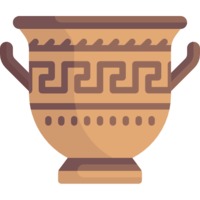Μουρνιές
Αντικείμενο
Τίτλος Σημείου Ενδιαφέροντος
el
Μουρνιές
en
Mournies
Περιγραφή / Απόσπασμα
68
en
The village of Murniés is somewhat less than three miles to the south of Khaniá, at the foot of the moun tains.
Σύγχρονη περιγραφή
el
Οι Μουρνιές είναι μια κωμόπολη, που βρίσκεται σε απόσταση τεσσάρων χιλιομέτρων νότια από το κέντρο των Χανίων. Το όνομα του οικισμού, σημαίνει Μουριές , καθώς τα μούρα στην κρητική διάλεκτο λέγονται μούρνα. Στην απογραφή του 1583 είχε 290 κατοίκους.
Στις αρχές του 17ου αιώνα στην περιοχή υπήρχαν ωραίες επαύλεις και ένα γυναικείο μοναστήρι του 15ου αι., μετόχι της μονής Χρυσοπηγής, αλλά πυρπολήθηκαν από τους Βενετούς. Το 1833 συγκεντρώθηκαν στις Μουρνιές περίπου 7.000 άτομα και διαμαρτυρήθηκαν για τη φορολογία που επέβαλε ο Αιγύπτιος Μοχάμεντ Άλι, αλλά η διαμαρτυρία οδήγησε στο κρέμασμα 30 Χριστιανών προεστών και στην εξορία των Τούρκων που συμμετείχαν. Το 1905 στο μοναστήρι της περιοχής, υπεγράφη ανάμεσα στον Ελευθέριο Βενιζέλο και στους αντιπροσώπους των Προστατίδων Δυνάμεων της Κρητικής Πολιτείας η συμφωνία με την οποία έληξε η Επανάσταση του Θερίσου. Νοτιοανατολικά των Μουρνιών βρίσκεται το Νοσοκομείο των Χανίων και μια παλιά τριώροφη έπαυλη, γνωστή ως Κουκουναρά. Η έπαυλη ήταν ενετική, αλλά κάηκε στην επανάσταση του 1821 και κατασκευάστηκε ξανά από τον Χαμίτ βέη Κασιμιζάδες το 1836. Στην έπαυλη έχουν φιλοξενηθεί ο σουλτάνος Αμπντούλ Μετζίτ, η Μαντάμ Ορτάνς, η Βασίλισσα Όλγα και ο Κωνσταντίνος Α΄ της Ελλάδας. Επίσης, στις Μουρνιές γεννήθηκε το 1864 ο μεγάλος Έλληνας πολιτικός Ελευθέριος Βενιζέλος, ενώ στην περιοχή αυτή βρίσκεται και το οικογενειακό σπίτι, όπου περνούσε τις διακοπές του όταν ήταν μικρός. Σήμερα λειτουργεί ως μουσείο, διαθέτει έκθεση ιστορικών φωτογραφιών αλλά και την παιδική κούνια του Ελευθέριου Βενιζέλου.
Στις αρχές του 17ου αιώνα στην περιοχή υπήρχαν ωραίες επαύλεις και ένα γυναικείο μοναστήρι του 15ου αι., μετόχι της μονής Χρυσοπηγής, αλλά πυρπολήθηκαν από τους Βενετούς. Το 1833 συγκεντρώθηκαν στις Μουρνιές περίπου 7.000 άτομα και διαμαρτυρήθηκαν για τη φορολογία που επέβαλε ο Αιγύπτιος Μοχάμεντ Άλι, αλλά η διαμαρτυρία οδήγησε στο κρέμασμα 30 Χριστιανών προεστών και στην εξορία των Τούρκων που συμμετείχαν. Το 1905 στο μοναστήρι της περιοχής, υπεγράφη ανάμεσα στον Ελευθέριο Βενιζέλο και στους αντιπροσώπους των Προστατίδων Δυνάμεων της Κρητικής Πολιτείας η συμφωνία με την οποία έληξε η Επανάσταση του Θερίσου. Νοτιοανατολικά των Μουρνιών βρίσκεται το Νοσοκομείο των Χανίων και μια παλιά τριώροφη έπαυλη, γνωστή ως Κουκουναρά. Η έπαυλη ήταν ενετική, αλλά κάηκε στην επανάσταση του 1821 και κατασκευάστηκε ξανά από τον Χαμίτ βέη Κασιμιζάδες το 1836. Στην έπαυλη έχουν φιλοξενηθεί ο σουλτάνος Αμπντούλ Μετζίτ, η Μαντάμ Ορτάνς, η Βασίλισσα Όλγα και ο Κωνσταντίνος Α΄ της Ελλάδας. Επίσης, στις Μουρνιές γεννήθηκε το 1864 ο μεγάλος Έλληνας πολιτικός Ελευθέριος Βενιζέλος, ενώ στην περιοχή αυτή βρίσκεται και το οικογενειακό σπίτι, όπου περνούσε τις διακοπές του όταν ήταν μικρός. Σήμερα λειτουργεί ως μουσείο, διαθέτει έκθεση ιστορικών φωτογραφιών αλλά και την παιδική κούνια του Ελευθέριου Βενιζέλου.
en
Mournies is a town, situated at a distance of four kilometers away from the center of Hania. The name of the settlement, means Mouries (berry trees), as in the Cretan dialogue, these trees are called Mournies. In the census of 1583, the town had 290 residents.
In the beginning of the 17th century, nice mansions existed in the area, as well as a female monastery dating from the 15th century, glebe of the monastery of Hrysopigi, but they were all burned by the Venetians. In 1833, about 7000 people were gathered in Mournies, protesting for the taxation forced to them by the Egyptian Mohamed Ali, but this protest lead to the hanging of 30 Christian dignitaries and to the exile of any Turks that participated in the protest. In 1905, at the monastery of the area, the agreement with which the Revolution of Therissos ended was signed between Eleftherios Venizelos and the representatives of the Protective Forces of the Cretan State. On the southeast side of Mournies, the Hospital of Hania is situated, and an old, three-storey mansion, known as Koukounaras mansion. The mansion was Venetian, but got burned during the 1821 revolution and was re-built by Hamit bei Kasizimades in 1836. The mansion has had some notable guests, such as sultan Abdulmejit, Queen Olga and Konstantine A’ of Greece. Also, in Mournies, in 1864, the great Greek politician Eleftherios Venizelos was born, while his family house is also situated in this area, where he used to spend his summer vacations when he was young. Today, it operates as a museum, it has an exhibition of historical photographs, as well as the cradle of Eleftherios Venizelos.
In the beginning of the 17th century, nice mansions existed in the area, as well as a female monastery dating from the 15th century, glebe of the monastery of Hrysopigi, but they were all burned by the Venetians. In 1833, about 7000 people were gathered in Mournies, protesting for the taxation forced to them by the Egyptian Mohamed Ali, but this protest lead to the hanging of 30 Christian dignitaries and to the exile of any Turks that participated in the protest. In 1905, at the monastery of the area, the agreement with which the Revolution of Therissos ended was signed between Eleftherios Venizelos and the representatives of the Protective Forces of the Cretan State. On the southeast side of Mournies, the Hospital of Hania is situated, and an old, three-storey mansion, known as Koukounaras mansion. The mansion was Venetian, but got burned during the 1821 revolution and was re-built by Hamit bei Kasizimades in 1836. The mansion has had some notable guests, such as sultan Abdulmejit, Queen Olga and Konstantine A’ of Greece. Also, in Mournies, in 1864, the great Greek politician Eleftherios Venizelos was born, while his family house is also situated in this area, where he used to spend his summer vacations when he was young. Today, it operates as a museum, it has an exhibition of historical photographs, as well as the cradle of Eleftherios Venizelos.




